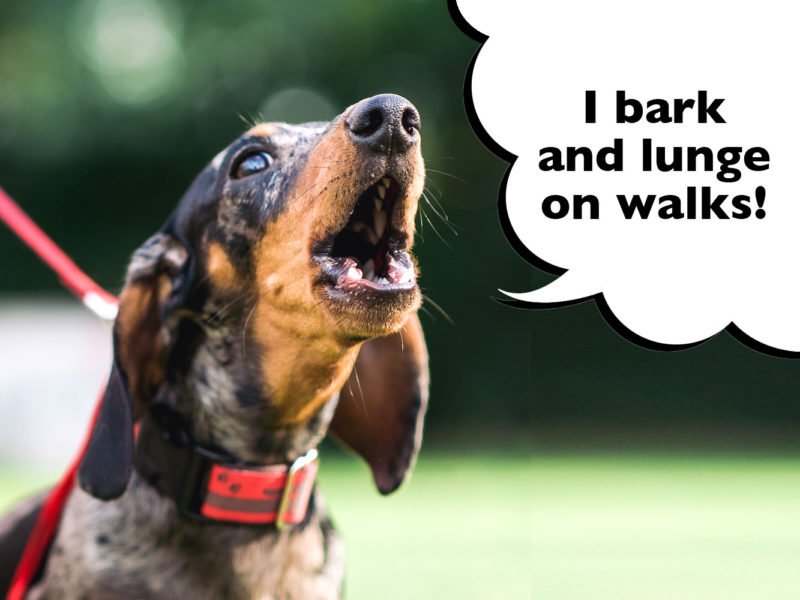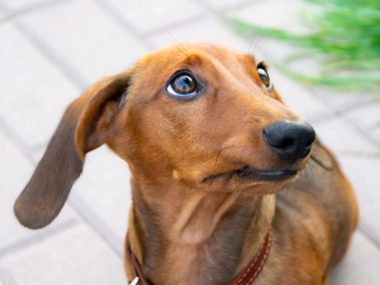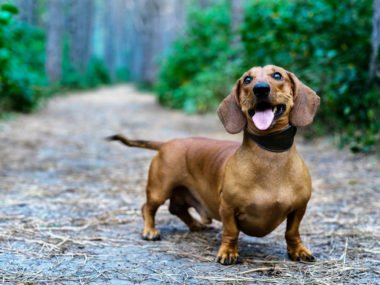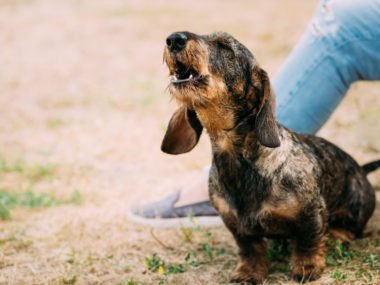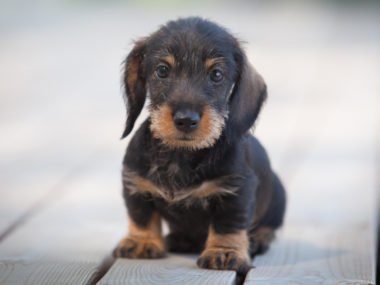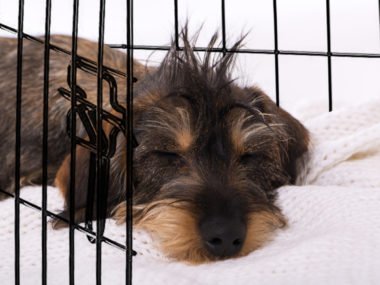Do you have a Dachshund that barks and lunges at people and other dogs when you’re out on walks? Are you starting to dread taking them out each day? Here’s everything you need to know about how to stop your Dachshund barking and lunging on walks.
How Do I Stop My Dachshund Barking And Lunging On Walks? Teach the ‘Watch Me’ command to divert your Dachshund’s attention away from the trigger and on to you instead. Start at a distance and gradually move nearer to people and other dogs over time. Keep calm and don’t shout as this can make it worse.
Read on to find out what reactivity in Dachshunds is, what causes it, and how you can stop it from happening when out on walks.
Table of Contents
This article is based on research and personal experience as a Dachshund owner of 10+ years. I’m not a Vet, qualified dog trainer or dog behaviourist.
What Is Reactivity In Dachshunds?
Reactivity is used to describe when your Dachshund overreacts to a certain situation or stimulus. More commonly, these are referred to as ‘triggers.’
Each dog will have different triggers. For some, it may be other dogs. For others, it may be strange people they haven’t met before.
They may bark or lunge and pull on the leash which can be very hard to manage.
Other common triggers for your Dachshund may include children, other animals, loud sounds, vehicles, high pitched noises and many more.
Reactivity is often confused for aggression, which is not the case. Dachshunds, as well as most other dogs, won’t use aggression if they can help it.
Their reaction usually comes from fearfulness, not aggression.
Is My Dachshund Reactive?
If your Dachshund lunges, barks or growls at other dogs or people out on walks, then they could be reactive.
Many owners confuse this reactivity with aggression which isn’t actually the case.
Reactive behaviour is more commonly shown because your Dachshund is feeling scared or anxious, not aggressive.
What Causes Reactivity In Dachshunds?
The most common causes of reactivity in Dachshunds are fear, anxiety, frustration or a lack of socialisation.
Because Dachshunds can generally be uncertain about new situations, it’s really important that they’re socialised well.
Without this, your Dachshund is more likely to become scared of strangers, other dogs, or new situations.
However, some Dachshunds can behave in the opposite way.
They can be so eager to go and greet other dogs and people on walks that they quickly become frustrated.
This frustration leads to reactive behaviours being displayed. These are most commonly barking and lunging.
Why Is My Dachshund Only Reactive On Walks?
This is a very common issue for Dachshund owners, who often can’t understand how their dog can be so well behaved at home, yet so reactive out on walks.
However, for a Dachshund that is anxious or un-socialised, the outside world can become a terrifying place.
They’re simply scared or uncertain and then start reacting out of fear.
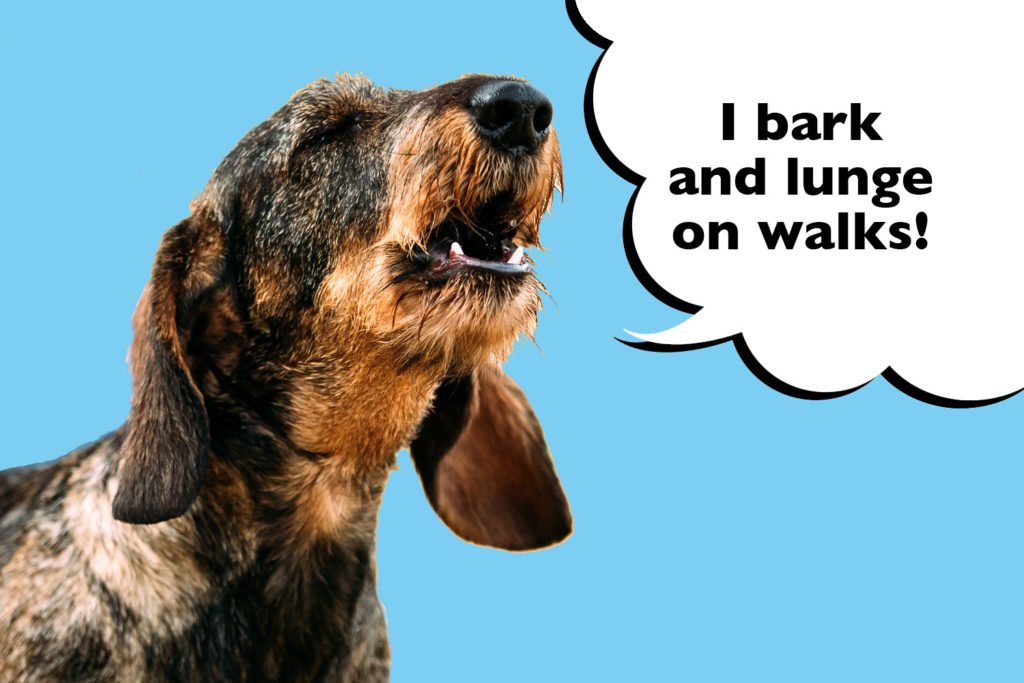
How To Stop Your Dachshund Barking Or Lunging On Walks
This is how to stop your Dachshund braking or lunging on walks:
Swap Over To A Harness
If you have a reactive Dachshund, the first thing you need to do is swap over to using a harness.
Dachshunds have fragile backs where 1 in 4 suffer from Intervertebral Disc Disease or IVDD.
So you need to be aware of the strain that all this pulling or lunging is putting on their neck and spine.
A harness will spread any pressure more evenly than a collar would.
Never Shout At Your Dachshund
If you shout at, or punish, your Dachshund for showing reactive behaviours, it’s likely to make them much worse.
Just as you wouldn’t punish a human for having a panic attack, you shouldn’t tell your Dachshund off for feeling scared and reacting accordingly.
They often feel like they have no other option but to behave in this way, as they’re feeling vulnerable and scared in the situation.
Don’t Force Your Dachshund
Some dog trainers still advocate the use of ‘flooding’ which is when your Dachshund is immersed in a situation that they’re uncomfortable with.
They aren’t allowed to leave until they’ve stopped showing reactive behaviours.
So, for example, if your Dachshund is reactive towards other dogs, they may surround them with other dogs, often in an enclosed space, until they appear calm.
This is an extremely controversial process, that can often result in your Dachshund’s reactivity getting worse.
In reality, your Dachshund won’t be feeling calm, they’ll simply shut down in a desperate attempt to be released from the situation.
So don’t force that on them, its better to take a more positive training approach.
Teach The ‘Watch Me’ Command
‘Watch Me’ is a great command to teach your reactive Dachshund to stop them barking and lunging on walks.
This encourages them to make eye contact with you directly, in return for a tasty reward.
In fact, it’s the best method to use with a reactive Dachshund to correct their behaviour while out on walks.
You can use this when you see a trigger in the distance and ask your Dachshund to ‘Watch Me’ to focus their attention on you instead of the trigger.
You can begin teaching your Dachshund this at home, where there aren’t any distractions around.
Simply hold a treat close to your face, and reward them every time they make eye contact with you.
You can then build this up so they’re looking at you for a couple of seconds before getting a reward and so on.
This is such a useful command to teach that can work really well for reactive dogs.
Use A High Value Treat
It’s best to use a high value treat to reward your Dachshund every time they encounter a trigger.
This could be a piece of fresh chicken or a tiny cube of cheese.
Although, don’t go too crazy with the cheese as this is too fatty for Dachshunds to eat longterm. This is just to get them motivated to look at you instead of any triggers!
So, if your Dachshund is reactive towards other dogs, you need to give them a tasty treat as soon as they see another dog in the distance.
This forms a positive association between the trigger and a reward.
If you keep dong this consistently, you can gradually turn down their reactivity over time.

Increase Distance
Increasing the distance between your Dachshund and their trigger, gives you more chance of reducing their reactive behaviour.
Generally, once the trigger is too close, your Dachshund simply won’t be able to focus on anything else apart from that.
So don’t put them in that situation until you’ve worked on the ‘Watch Me’ command and have more control over the situation.
You want to get some successes under your belt and increase your Dachshund’s confidence before decreasing the distance.
Go Slowly
Helping your Dachshund overcome their reactivity can be a lengthy process, but it shouldn’t be rushed.
If your Dachshund is making some improvements, don’t be tempted to push them too far.
If you try and rush your Dachshund, it might make their reactivity worse because they feel out of control of their environment.
Set Your Dachshund Up For Success
If your Dachshund is reactive towards small children, then don’t walk them near to a children’s play park where there’s likely to be lots of kids around.
By choosing to avoid areas where you know that triggers will be high, you’re setting your Dachshund up for success instead of waiting for them to fail.
This’ll help to build your Dachshunds confidence on walks, which can be the key to overcoming their reactivity.
Keep Calm
Sharing your life with a reactive Dachshund can feel very stressful.
However, your Dachshund can pick up on your tension and anxiety, which can often make their reactivity worse.
If you tense up and pull their leash tight when you see another dog approaching, your Dachshund is actually more likely to react.
Dachshunds are very loyal and protective of their owners so, if they sense you’re on edge, they’ll start to think there’s something to worry about.
It’s best to stay calm, walk with a slack leash and maybe take a friend with you to help you feel more at ease.
Be Aware Of The Bigger Picture
Trigger stacking is the term used when your Dachshund experiences lots of small triggers in a short space of time, which then cause them to react negatively.
Imagine an empty glass and each trigger symbolises a little bit of water being tipped into it. Eventually, the glass will overflow which symbolises the reactivity your Dachshund shows.
So, if your Dachshund sees a cat, that tips some water into their cup. Then the doorbell rings and that tips some more water in. Next, the postman delivers a parcel which means more proverbial water being added.
So, by the time your Dachshund sees another dog out on a walk, their cup will overflow and they’ll be much more likely to show reactive behaviour.
Give Your Dachshund A Break
If your Dachshund experiences a particularly stressful walk, it’s a good idea to give them plenty of time to rest afterwards.
Dog trainers call this a ‘Cortisol Holiday’ whereby you give your Dachshund time to reduce the Cortisol levels in their systems and feel calmer again.
Cortisol is released when your Dachshund is stressed which is why it’s an issue for reactive Dachshunds.
By opting to avoid potential triggers for a few days afterwards, this gives your Dachshund time to unwind.
If you carry on exposing them to triggers when they’re already feeling stressed, you can guarantee their reactive behaviour will get worse.
Will My Dachshund Always Be Reactive?
No, your Dachshund won’t necessarily always be reactive.
It’s possible to reduce your Dachshund’s reactivity through positive reinforcement training like teaching the ‘Watch Me’ command.
However, you will have to put some time into this and be consistent with the training every time you go out.
It may also help to do this training under the supervision of a qualified trainer or dog behaviourist because they’ll be able to show you what to do in person.
It’s also important to remember that being reactive is not the whole personality of your Dachshund.
They’re often able to live happy, stress-free lives which are only interrupted by them being exposed to triggers – which you can definitely work on over time!
So, there you have it! Dachshunds can be reactive by barking and lunging on walks when they’re nervous or unsure of what’s going on around them. It’s best to teach the ‘Watch Me’ command to divert their attention away from the trigger and on to you instead. Start by keeping a distance from people and other dogs and then gradually move closer in stages. Go slow and be patient to reduce your Dachshund’s reactivity over time!
What do I do next?
If you read all the way to the end of this article, you’re exactly the sort of person I’d LOVE to join my Facebook Group. Your support for my blog means everything to me so, if you found this article helpful, please kindly share below. Thank you! 💋


